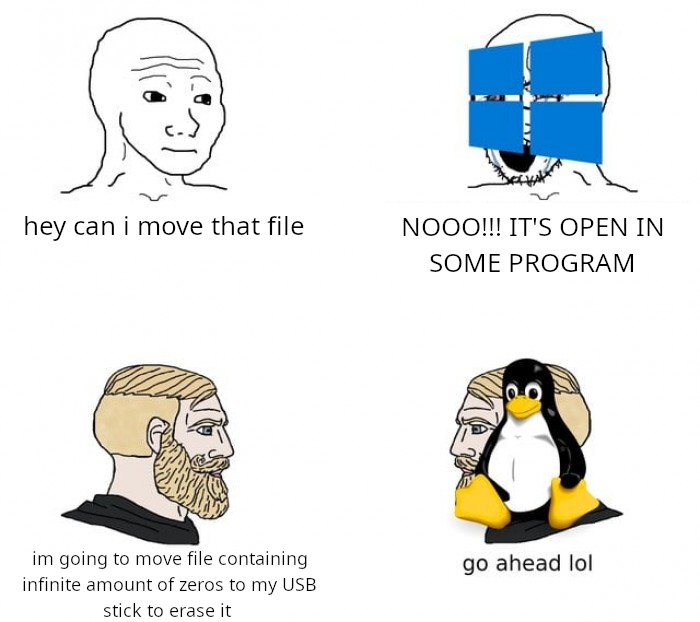this post was submitted on 20 Apr 2024
979 points (97.2% liked)
linuxmemes
21272 readers
520 users here now
Hint: :q!
Sister communities:
- LemmyMemes: Memes
- LemmyShitpost: Anything and everything goes.
- RISA: Star Trek memes and shitposts
Community rules (click to expand)
1. Follow the site-wide rules
- Instance-wide TOS: https://legal.lemmy.world/tos/
- Lemmy code of conduct: https://join-lemmy.org/docs/code_of_conduct.html
2. Be civil
- Understand the difference between a joke and an insult.
- Do not harrass or attack members of the community for any reason.
- Leave remarks of "peasantry" to the PCMR community. If you dislike an OS/service/application, attack the thing you dislike, not the individuals who use it. Some people may not have a choice.
- Bigotry will not be tolerated.
- These rules are somewhat loosened when the subject is a public figure. Still, do not attack their person or incite harrassment.
3. Post Linux-related content
- Including Unix and BSD.
- Non-Linux content is acceptable as long as it makes a reference to Linux. For example, the poorly made mockery of
sudoin Windows. - No porn. Even if you watch it on a Linux machine.
4. No recent reposts
- Everybody uses Arch btw, can't quit Vim, and wants to interject for a moment. You can stop now.
Please report posts and comments that break these rules!
founded 1 year ago
MODERATORS
you are viewing a single comment's thread
view the rest of the comments
view the rest of the comments

Never thought about that, but since these tools just work, when you copy them to your PC.... how does psexec do that? It'd either need you to be an administrator (and then it's not really a privilege escalation as you could have registered any program into the task scheduler or as a service to run as SYSTEM) or it'd need a delegate service, that should only be available when you use an installer - which again wasn't was has been done when just copying the tool.
You need Administrative permissions for psexec. It uploads a file to the target computer's \admin$ share (just C:\Windows) and starts a service to execute it. Services run as SYSTEM so that's why you get those privileges.
(Hah, I forgot your message while typing mine and just copied you :)
Edit: fixed c$ to admin$
I found a blog post outlining exactly that. If you use it locally, it will install and start a service temporarily. That service runs as SYSTEM and invokes your command. To succeed, you need to be a local administrator.
If you try the same remote, it tries to access \\remote-server-ip\$admin and installs the service with that. To succeed your current account on your local machine must exist on the remote machine and must be an administrator there.
So in short: It only works, if you've already the privilege to do so and the tool itself is not (ab)using a privilege escalation or something like that. Any hacker and virus may do the very same and doesn't need psexec - it's just easier for them to use that tool.
Thank you for clearing it up!
And regarding your assessment: Exactly!